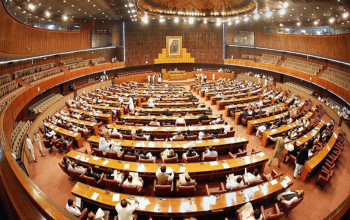Mohammad Khan, a 40-year-old fisherman from Goth Sain Dino Mallah, in Jamshoro town, on the banks of the Indus River, has spent his entire life fishing. Presently, however, his community is struggling to make ends meet.
It was evening, when I reached downstream. He was taking the catch out of the net. Netting in the receding waters of the Indus, he spends 10 hours a day hoping to catch enough fish to feed the seven members of his family.
“Saeen, you have been catching fish single-handedly?” I asked him.
“I hardly catch two kilogrammes of which after putting in so much hard work,” he replied with a wistful smile. “If I involve others, after sharing out, the fish that would hardly suffice anyone.”
There was a time when five or more people would go out on the river to catch fish.
“The Indus used to be full of fish and brought prosperity to all,” he elaborates. “But now, despite our tireless efforts, we barely earn Rs 800 a day.” According to Khan, small fish is priced at Rs300 to 400 per kilogramme, while bigger fish is no longer available.
Earlier, fish was caught on contract basis, but now only a few fishermen earn a living by fishing individually. Previously fish was more affordable people consumed more as it an important part of our diet, but now it has become a delicacy.
Several generations in Sindh, have flourished on the rich waters of the Indus. But presently the lifeline that sustained the locals and their communities for centuries is in grave danger. The province was once known for its vibrant ecosystem and a thriving fishing industry, is confronted with an increasing water scarcity.
The goths [villages] around Jamshoro are inhabited by fishing communities. The mud houses in these villages tell stories of poverty and deprivation. There are no streets, no water supply or drainage system.
Despite being 12 kilometres away from the rapidly growing metropolitan city of Hyderabad and just five kilometres from Jamshoro, popularly known as the education city, the village of Rehri Mian with over 500 houses along the Kotri barrage has no roads or facilities.
Faqeer Imdad Mallah, 56, is an experienced fisherman who has spent his entire life battling the waves riding the steady flow of the Indus. He fondly remembers the days when the river was full of life, but now, he too is disappointed to see the shrinking river.
“We are not given our share of water,” says Imdad pointing out that the water shortage in the river is not natural. “This is why millions of fishermen like us are in this dire situation.”
According to him, two decades ago, the weight of the palla fish used to be more, but now it is not more than 500 grammes. Also, it has decreased in numbers. Other varieties such as catla, the giant river cat fish, walking cat fish, Asian cat fish, bird fish, and labeo gonius have also become scarce.
According to an inter-provincial water-sharing agreement signed in 1991, it was agreed that 10-million-acre feet of water would be released annually from the Indus River to the Kotri downstream. But it was never implemented.
The Indus River System Authority (IRSA) recently announced an increase in water allocations for Punjab and Sindh provinces during the early khareef season of 2024. This decision was made in response to the water shortage situation, following an urgent meeting chaired by Abdul Hameed Mengal at IRSA headquarters.
The revised allocations reflect a substantial increase in water shares, with Punjab’s allocation rising from 9.266 mean annual flow (MAF) to 12.424 MAF, and Sindh’s from 5.548 MAF to 8.292 MAF for khareef 2024. This increase of 3.744 MAF underscores IRSA's commitment to ensuring water distribution among the provinces to support agricultural activities and mitigate water scarcity challenges in the respective provinces.
Furthermore, IRSA decided to expedite the filling of Tarbela Dam to 1470 feet by June 30, 2024, instead of the previous target of July 20, 2024, based on updated information from WAPDA. These measures align with IRSA's proactive approach to water management, ensuring equitable distribution and efficient utilisation of water resources as outlined in the Water Apportionment Accord (WAA) 1991.
According to the Department of Livestock and Fisheries Sindh, out of the 600,000 population of fishermen on the Indus, 100,000 of them depend on freshwater fishing for their livelihood.
Fishing communities are usually the first ones to face the consequences of natural disasters and weak natural resource management, and are unwilling to adopt or change better fishing practices or alternative livelihoods.
The sustainability and growth prospects of the fishing sector were being affected by over-exploitation of resources and high poverty levels of fishermen who suffered at the hands of middlemen and contractors because of limited access to their own better practices, finances and assets.
According to environmentalists, the reasons for the lack of fish in the Indus River are water scarcity, pollution, and climate change.
Environmentalist Nasir Panhwar, a former coordinator of the WWF and author of a book on Sindh's environmental issues, says that if the agreement had been implemented and its share of water had been available every year, this would not have been the condition of the river.
Discussing the grim reality of the Indus, Panhwar emphasised that the Indus River is on its last breath, as the water barely reaches the Kotri downstream. When the river water does not even reach the Indus delta, how will the fish survive in such a situation? The shortage of water in the river directly impacts the growth of fish.
Irshad Laghari, a 50-year-old journalist from Hyderabad, has been writing on environmental issues for The Sindh Express since 2013. “The Indus River is closed on several fronts,” he says. “A number of factors such as little or no water released from Punjab, construction of dams, industrial and urban pollution and uncontrolled disposal of waste in rivers has polluted the river water and caused the decrease in numbers of fish.
He adds that sadly, under the inter-provincial agreement, 10-million-acre feet per year for the Indus River delta has never been given, resulting in a gradual shortage of water. This is why different species of fish have also disappeared without the required water.
As early as 2016, Jane Qiu a Beijing-based journalist and researcher, in an article in a web magazine Nature, alerted that the Indus River threatens Pakistan’s water supply. It
stated that a flow of 5,000 feet 3/s (141.584 cubic metres per second) from the Kotri Barrage into the sea is necessary to maintain coastal fishing, prevent the accumulation of salt coming from the sea and prevent sea water from moving forward.
Qiu’s report revealed that the Indus River, vital to the lives of 300 million people, is supplying Pakistan with less water than it was half a century ago. This shortfall in water supply, especially during the spring and summer months, coincides with the expected increase in demand.
As there is a shortage of fish due to this crisis, many indigenous fishermen are now leaving their ancestral occupation and doing other labour to feed their families. Among them is 17-year-old Farhan Mallah, who now earns a few hundred rupees by facilitating recreational horse rides for those who come to the recreation site Al-Manzar near Kotri barrage. “Since, we cannot survive as fisherman, I work here to generate around Rs 700 to 1000 per day.
Riaz Mallah,38, who was a also a fisherman previously is now employed at Kotri Barrage along with many others as labourers. Most of our fishing community moved to Karachi, while some settled in Badin.
He says the boats that were previously used for fishing are now being utilised for recreational boat rides for people who come to the beach. “This way we can at least provide two meals a day for our families,” adds Riaz.
The migration of indigenous fishermen reflects the human cost of this crisis, pushing communities to seek alternative livelihoods. In this dilemma, the Indus River’s plight is a call to action for comprehensive policies, and environment activism to save Indus River for the benefit of ecological preservation, indigenous livelihood in Sindh.
Rahmat Tunio is a multimedia journalist based in Karachi, Sindh, who covers environment, social justice. He can be reached at @RehmatTunio or alirehmat36@gmail.com
All facts and information are the sole responsibility of the writer
Read the full story at the express tribune website.

